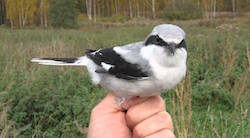
Tales of Remarkable Birds
Dominic Couzens
(Bloomsbury)

When we moved here twenty-five years ago, we planted a bevy of trees: Coulter and Knobcone Pines, Western Sycamore, the Monkey Puzzle Tree and the Indian Laurel Fig. I am easily sucked in by anything with leaves, cones and bristles. They cool the air, they enrich the soil, they please the soul.Also they bring the birds, and we are all birdheads here. The songs: the linnet --- the house finch --- babbling to each other (one of my friends says they are gossiping about us); the mockingbird, what one birdologist called "The Noisiest, Most Aggressive Small Bird You'll Ever Meet." The scrub jay sniping at the neighboring cats and dogs; the American crow laughing at all of us, the shy Pacific wren Troglodytes pacificus, and the eye-popping thrushes.
And, with their names, those who we can only dream of . . . maybe here, maybe not: the Spotted towhee, the Hepatic tanager, Le Conte's thrasher, the Plumbeous vireo. The hungriest (the Sandwich tern). The loner in the crowd (Townsend's solitaire). The solo drinker (the American dipper). The loser in the bunch (Least flycatcher).
Then there's Hoagy Carmichael's favorite (Alauda arvensis d/b/a "Sky lark"); the Donald Trumps of the bird world (Tyrant flycatchers); ones to shake you up at night (the Flammulated owl); the most mysterious, perhaps divine, of them all: the Marbled godwit.
But something strange is happening in my cool garden of flowers and trees and the cool ocean winds. It's called silence. Most noticeable this year most of all. The linnets that would chat with each other (and me): no more. The mockingbirds mocking. Even the pesky little English sparrows. The scolding jays and their deadly enemies: gone. Can it only be the cats that swarm out of the neighborhood? Are they bringing on what Rachel so bleakly called the "Silent Spring?" Does anyone else notice --- not just here, but everywhere we go --- that the days and nights are coming more ominous in their lack of song? Is it just me? I don't see much in the newspapers or online. O wait: one other writer, that salty Mark Morford. Just a couple of weeks ago, in a column called "Say goodbye to all the wild animals," he wrote of this sinister hush, this eerie quiet.
Have you noticed the vast decrease in wild birdsong your neighborhood trees in the morning lo these past decades? Fewer and fewer songbirds chirping away? You might not: the roar of modern life easily drowns out the rhythms of nature. But it's happening, on a vast and terrible scale. Birds are vanishing by the tens, if not hundreds of millions, and the culprits are everywhere: Habitat loss. Climate change. Thoughtless slaughter. Wind turbines. Too many cats.
It's true. Stick your head out the window if you are fortunate enough to live where there are trees, shade, some calm. Tell me what you hear in the early morning, late in the afternoon. Nothing? Can it be? Is it possible that some day soon the only strange and wonderful birds we will see will be between the covers of a book like Tales of Remarkable Birds.
And they are remarkable --- all thirty-nine that appear here, with lush full color pictures, and an apt, entertaining text.
When all our native species are gone, must we depend solely on the migrants --- not in their leaky boats looking, dispairingly, for livelihood and lodging --- but, the other ones, the winged ones, the ones in flight, as it were? Must we only see them in the lovely photographs here?
Like the Yellow-Browed Warbler. They come to life from the Urals to the Russian Sea of Okhotsk, at the southern fringe of Siberia. They usually spend their winters in the sweat shops of north-east India, the electronic factories of Taiwan. But suddenly they are making appearance in western Europe. It's all very logical, if you accept the fact that migrating birds are guided by the magnetic fields of the earth. And if you turn the great curve a full 180° --- the tracking would lead them to Germany, England. Sweden, Scotland. Some think they may be wintering in Europe because of the grog shops and lurid nightime activities, never to be found in sour-faced Taiwan.
Or take the Andean Cock-of-the-rock. It's got to be the oddest bird, or not really a bird at all with its tiny yellow beak and racy head knot, yellow-rimmed eyes and this feathery lump, making it look more like a red-headed ball-peen hammer. According to Couzens, these show-offs --- and they do spend most of their days doing what we used to call the "South Jersey Surf Turkey" routine, preening and wooing the ladies with their lazy, colorful, easy ways. The female of the species should be forwarned --- avoid these sluggards and lay-abouts. Once they indulge in their namesake activity, they take the rest of the year off to preen some more, attract attention of their duller-colored lady friends as best they are able, lotta sweet-talk and cuddling up, looking for a kiss.
--- Richard Saturday